Link to COMPASS alcohol brochure
Changes to the alcohol environment
- There have been a number of provincial government-led changes, such as extended hours of sale, and changes to where alcohol can be consumed and purchased, that may shift the social environment surrounding consumption.
- Youth in the jurisdictions exposed to the latest change in LCBO policy authorizing grocery stores to sell alcohol are more likely to transition from abstinence to high-risk regular drinking and high-risk regular drinkers are more likely to maintain their behaviours (Gohari. et al, under review)
Trends in frequency of alcohol use among students in the COMPASS Study
Did you know?
- Among Ontario students participating in the COMPASS study in 2018/10, 41% of males and 37% of females aged 15-19 have had more than a sip of alcohol in the last 30 days.
- Among grade 12 students participating in the COMPASS study in 2018/19, 75% have had more than a sip of alcohol at least once in their lifetime.
- "Male and upper grade students had greater likelihood of engaging in high [risk] level patterns of alcohol consumption." (Gohari et al, 2020)
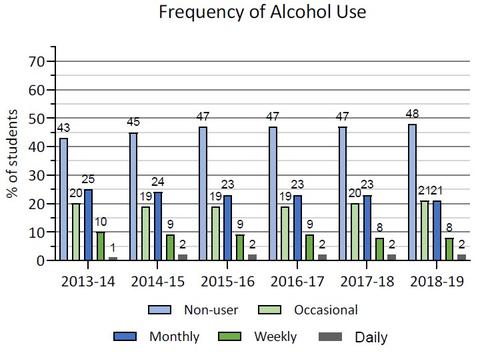
This figure describes the frequency of alcohol use between 2013/14 and 2018/19; non-use, occasional, and daily use has increased, and weekly and monthly use has decreased over this time.
Alchol use is defined as any use that was more than just a sip in the last 12 months.
Source: 2013-14 to 2018-19 COMPASS Ontario schools.
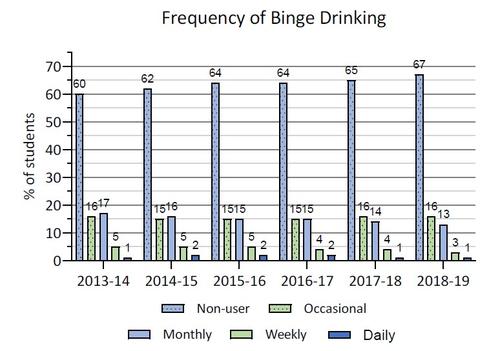
This figure describes the frequency of binge drinking between the years of 2013/14 and 2018/19; non-use has increased, weekly binge drinking has decreased, and occasional, monthly, and daily binge drinking has remained stable over this time.
Binge drinking is defined as consuming 5 drinks of alcohol or more on one occasion in the last 12 months.
Source: 2013-14 to 2018-19 COMPASS Ontario schools.
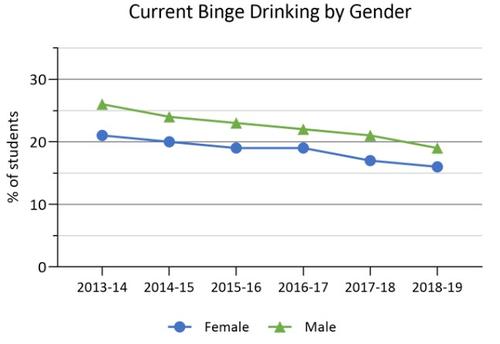
This figure describes the percent of male and female students who currently binge drink between 2013/14 and 2018/19; use has decreased in both genders, and female use has remained consistently lower than male use over this time.
Source: 2013-14 to 2018-19 COMPASS Ontario schools
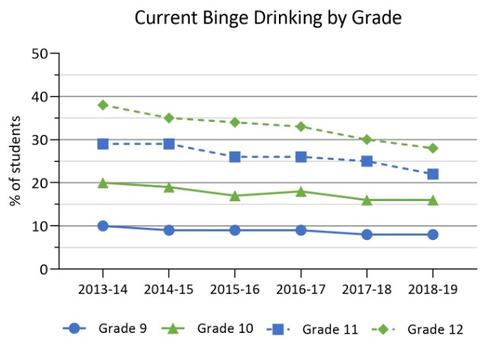
This figure describes the percent of students in grade 9, 10, 11, and 12 who currently binge drink between 2013/14 and 2018/19; binge drinking increases with each grade, and has decreased in all groups over this time.
Source: 2013-14 to 2018-19 COMPASS Ontario schools
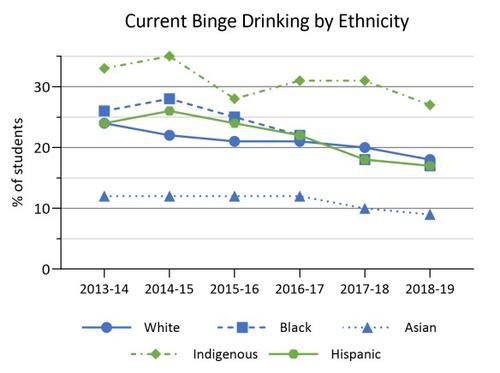
This figure depicts the rates of binge drinking between 2013/14 and 2018/19 among White, Black, Asian, Indigenous, and Hispanic students. Indigenous students have the highest frequency of binging, followed by White, Black and Hispanic, and Asian students. Binge drinking among all students has decreased over this time.
Source: 2013-14 to 2018-19 COMPASS Ontario schools
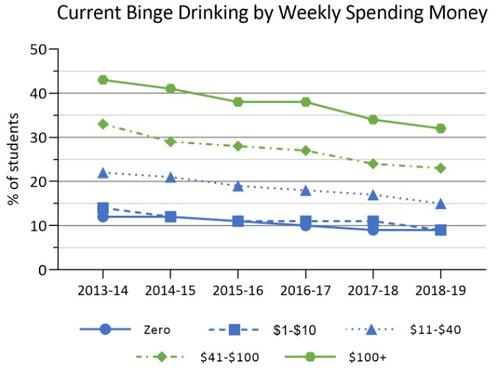
This figure describes the percent of students who currently binge drink based on weekly amounts of spending money between 2013/14 and 2018/19. Students with $100+ use the most cannabis, followed by those students who value between $41-$100, $11-$40, $1-$10, and zero dollars of weekly spending money. Binge drinking among all groups has decreased over this time.
Source: 2013-14 to 2018-19 COMPASS Ontario schools
Age of alcohol use in initiation among grade 12 students in 2018/19
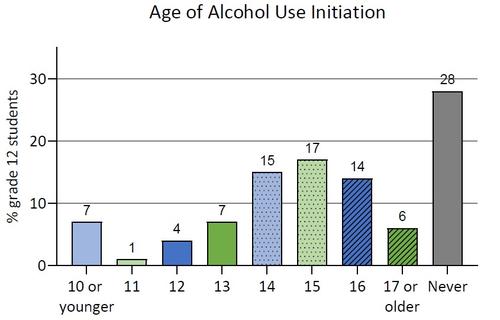
This figure describes the age of alcohol initiation among grade 12 students; 28% had never drunk, 7% stated at 10 or younger, 1% started at 11, 4% started at 12, 7% started at 13, 15% started at 14, 17% started at 15, 14% started at 16, and 6% started at 17 years or older.
Source: Participating students from 2018-19 COMPASS schools
Health behaviours and early initiation to alcohol consumption
- Early initiation of alcohol consumption increases the likelihood for older students to engage in heavy drinking. (Gohari et al, 2019)
- "Youth engaging in current binge drinking were approximately three times more likely to smoke tobacco and almost eight times more likely to use cannabis." (Butler et al, 2019)
- Students who started binge drinking in grade 10 or 11 had larger body weight and BMI increases in comparison to those who never became binge drinkers. (Vermeer et al, 2019)
- Younger age of first alcohol use was associated with increased Moderate to Vigorous Physical Activity (MVPA) in grade 12. (Williams et al, 2019)
Relating youth binge drinking to other health behaviours and outcomes
- The most common dual use of substances were alcohol and e-cigarettes. (Zuckermann et al, 2019)
- Grade 12 students with higher levels of school connectedness were more likely to use alcohol and binge drink. (Holligan et al, 2019)
- Team sport participation has been shown to be associated with binge drinking among COMPASS student participants. (Butler et al, 2019)
- Among adolescent girls, those who were considered dieters were at increased risk of becoming involved in binge drinking in subsequent years. (Raffoul et al, 2018)
- "Adolescents who initiate binge drinking have a relatively higher risk of poor academic performance, and a lack of preparedness and engagement" (Patte et al, 2017)